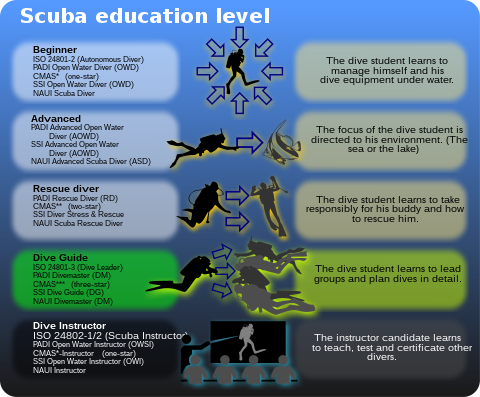Rescue Diver
This is an old revision of this page, as edited by Pbsouthwood (talk | contribs) at 18:46, 18 April 2020 (→Footnotes). The present address (URL) is a permanent link to this revision, which may differ significantly from the current revision.
This article includes a list of general references, but it lacks sufficient corresponding inline citations. Please help to improve this article by introducing more precise citations. (August 2009) (Learn how and when to remove this message) |
Rescue Diver is a scuba diving certification level provided by several diver training agencies, such as PADI,[1] SSI,[2] SDI,[3] and NAUI,[4] which emphasises emergency response and diver rescue.

The certification level is loosely equivalent the CMAS ** Diver qualification and the BSAC sports diver, although the European courses tend to be longer and more intensive than their U.S. counterparts.
Most organizations have a minimum age requirement of 15 to undertake the Rescue Diver course, although PADI does permit certification of "Junior" Rescue Divers.
Background

The Rescue Diver course is the third level qualification in the American international system,[clarification needed] following the Advanced Open Water Diver qualification (AOWD). Historically the course was treated as a separate "speciality" rather than a mainstream certification in itself (and arguably it still is in many organization's certification structure), but most advanced training is contingent upon having previously completed the Rescue Diver certification, and thus it effectively becomes a tier in the training.[citation needed]
The European International dive education system CMAS recognises only three main levels of dive education indicated by a one star, two star, or three star system. One star indicates an ability to dive, two star indicates additional skill of rescuing divers, and three star indicates the additional skill in leading a group of divers.[citation needed][needs update]
Training
The course usually covers most of the following topics:
- Self-rescue and diver stress
- Emergency management and equipment
- Panicked diver response
- In-water rescue breathing protocols[5]
- Egress (exits)
- Dive accident scenarios
In many training agencies, these dives represent introductory knowledge and skills that may be further refined in a speciality course.
Sources
- PADI Rescue Diver Manual, ASIN:B0000DYV1X
- PADI Rescue Diver Course Description, [1]
Footnotes
- ^ Who refer to the course as Rescue Diver
- ^ The SSI course goes by the name: Diver Stress and Rescue
- ^ Who refer to the course as Rescue Diver
- ^ The NAUI course goes by the name: Rescue SCUBA diver Archived 2009-03-28 at the Wayback Machine
- ^ Mitchell, Simon J; Bennett, Michael H; Bird, Nick; Doolette, David J; Hobbs, Gene W; Kay, Edward; Moon, Richard E; Neuman, Tom S; Vann, Richard D; Walker, Richard; Wyatt, HA (2012). "Recommendations for rescue of a submerged unresponsive compressed-gas diver". Undersea & Hyperbaric Medicine. 39 (6): 1099–108. PMID 23342767. Retrieved 2013-03-03.
- Webarchive template wayback links
- Articles with short description
- Short description matches Wikidata
- Articles lacking in-text citations from August 2009
- All articles lacking in-text citations
- Wikipedia articles needing clarification from May 2019
- All articles with unsourced statements
- Articles with unsourced statements from May 2019
- Wikipedia articles in need of updating from May 2019
- All Wikipedia articles in need of updating
- All stub articles
